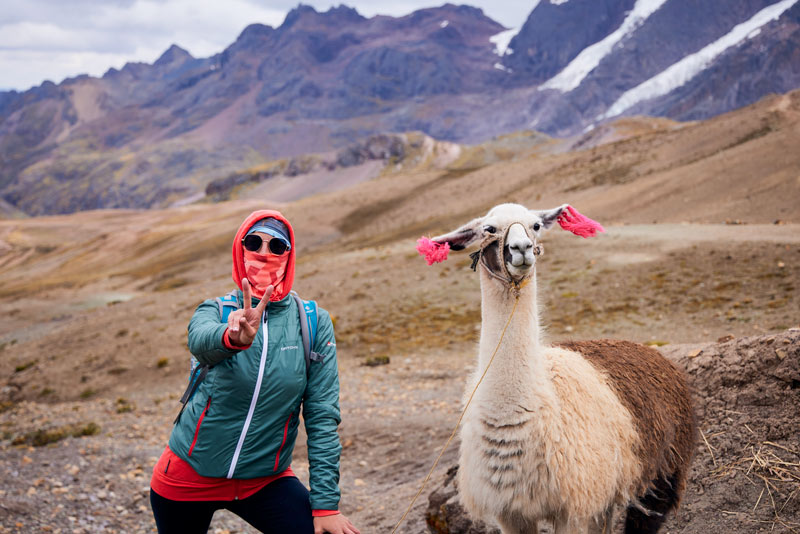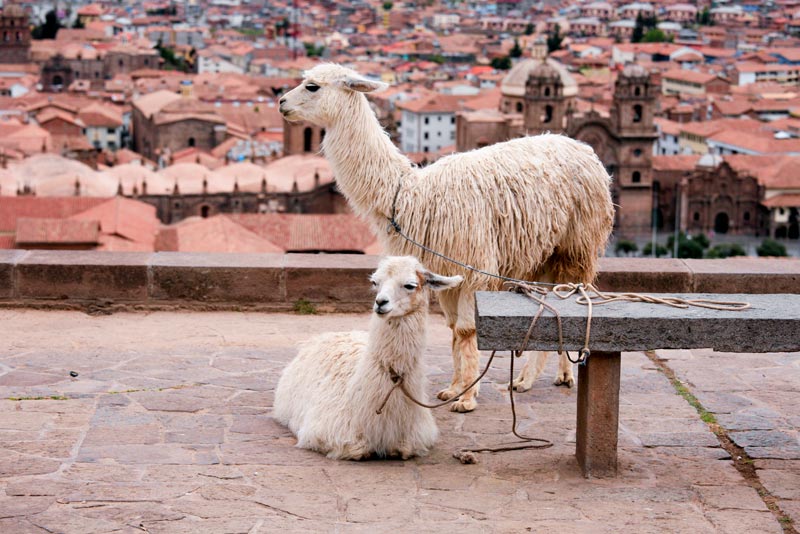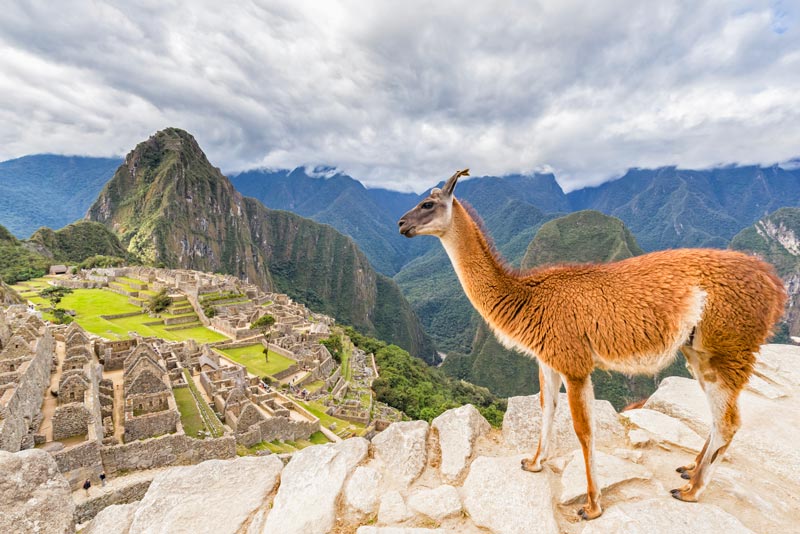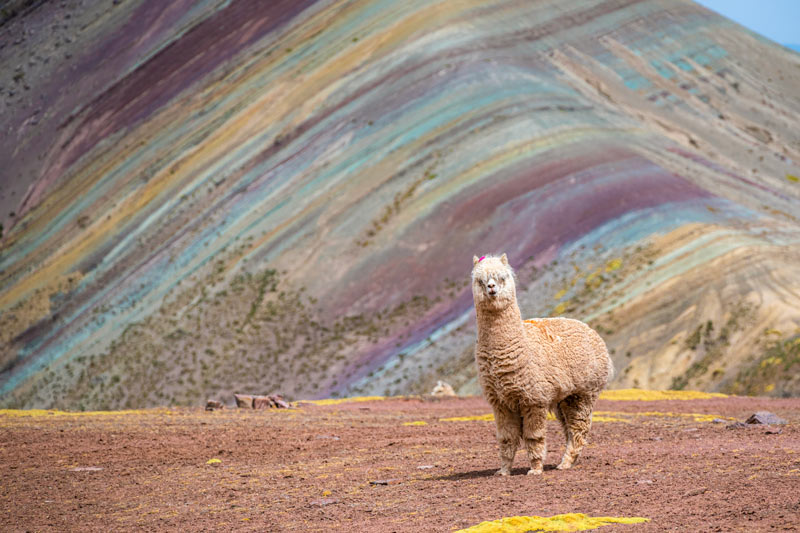Places to see llamas and alpacas near Cusco
Are you traveling to Cusco and dreaming of taking a picture with a llama or alpaca? Today we’ll introduce you to the best places where you can make your dream come true alongside these famous aucanids, and the best part is, you don’t have to travel far to find them. Learn more about these animals, which you’ll only find on your tour of the Andean region of Cusco.
- The llamas and alpacas of Cusco
- Where to see llamas and alpacas in Cusco?
- What is the difference between a llama and an alpaca?
- Tips for your trip to Cusco
- Frequently Asked Questions
The llamas and alpacas of Cusco
The natural habitat of llamas and alpacas is the Andean mountains of South America. This is primarily the case in Peru and Bolivia, thanks to their altitude, as these auchenids often live between 2,500 and 4,500 meters above sea level.
Llamas and alpacas are herbivores that typically live in open, grassy landscapes. Today, they are domesticated animals that serve a variety of functions in the Andean region, from being raised for meat to serving as pack animals and even guarding other herds. Their fur is also often used to make high-quality clothing, as llamas and alpacas have very soft wool, ideal for delicate garments.
Where to see llamas and alpacas in Cusco?
Since the time of the Incas, llamas and alpacas have been considered sacred animals, and today they are a reflection of Andean culture, not only for their productive value but also for their symbolic and even aesthetic value, given their beautiful and gentle nature. Discover the best places to see alpacas and llamas in Cusco:
The Historic Center of Cusco
Without going far, you can find llamas and alpacas in the center of Cusco city. A good place to first get your bearings is the Plaza de Armas, from where you can head toward Hatun Rumiyoc Street, where the 12-angled stone is located. Llamas and alpacas are always there. You can also see them if you head toward Plateros Street.
They are generally people who bring these animals from communities, so they will usually ask you for a tip in exchange for taking photographs with their llamas and alpacas. In many cases, you will even see small babies that will make your experience much more exciting.
The archaeological park of Sacsayhuamán
While exploring Sacsayhuamán, you’ll also be accompanied by llamas and alpacas at almost every turn. The Sacsayhuamán Archaeological Park is a historical attraction located just 25 minutes from downtown Cusco, from where you can also explore many flora-filled sites and viewpoints throughout the city where llamas and alpacas roam freely.
To enter the Sacsayhuamán archaeological park, you’ll need the Cusco tourist ticket for circuit one. This ticket will give you access to these beautiful animals and a tour of one of the most impressive Inca architectural monuments, with giant walls weighing up to 128 tons.
The Cusco Tourist Ticket
To see the main attractions of Cusco, you’ll need the Cusco Tourist Ticket for Circuit One. This ticket not only gives you access to the Sacsayhuamán archaeological park, but also to the Qenqo archaeological center, the Puka Pukara archaeological site, and the Tambomachay archaeological complex. This ticket can be used in one day, since all the attractions are very close to each other, giving you a much more complete experience.
The community of Chinchero
Traveling a little further from the city, you’ll find a larger number of llamas and alpacas in the community of Chinchero, located 1 hour and 30 minutes from Cusco. There, you can visit places dedicated to raising these animals, so you can see them in all their sizes and colors.
Chinchero is a town famous for its archaeological site, as well as being an Andean community that preserves its ancestral textile knowledge, where they handcraft many garments with llama and alpaca wool. It’s an ideal place to take home a souvenir of these beautiful animals.
The citadel of Machu Picchu
Visiting Machu Picchu, the Wonder of the World, also comes with the presence of these incredible animals. Across most of Machu Picchu’s agricultural terraces, you’ll be able to see llamas and alpacas going about their daily lives, roaming the citadel at their own pace and convenience. (The best time to visit Machu Picchu).
To visit the Inca citadel, you’ll need to book your ticket at least a month in advance. If you want to experience an adventure within the citadel, such as Huayna Picchu, you must book at least three months in advance. It’s a must-see on your trip to Cusco, from where you can experience stunning landscapes, historical sites, and meet the beautiful llamas and alpacas of Machu Picchu.
Machu Picchu Circuits
When you purchase your ticket to Machu Picchu, you’ll notice that there are three circuits with different routes that segment the Inca citadel. These include: Circuit One – Panoramic Route (four types of tickets), Circuit Two – Classic Route (two types of tickets), and Circuit Three – Royal Route (four types of tickets). Remember to book your ticket at least one or two months in advance to ensure you get a spot on your ideal route.
The Rainbow Mountain
One of the most visited destinations in Cusco, after Machu Picchu, is Rainbow Mountain. From this spot, more than 5,200 meters above sea level, we can find llamas and alpacas brought by some members of the community so we can take the perfect photo with the Rainbow Mountain in the background.
To reach Rainbow Mountain, we’ll have to embark on a three-hour tour from Cusco to Phulawasipata. From here, a two-hour hike begins along a somewhat demanding stretch, but it can also be easily overcome by renting horses. Throughout the journey, you’ll be surrounded by the most beautiful natural landscapes, along with mountain ranges and snow-capped peaks. To take photos with the llamas and alpacas, we’ll have to leave a symbolic tip for the owners of these animals.
What is the difference between a llama and an alpaca?
If you’re also one of those who can’t tell a llama from an alpaca, we’ll share the main characteristics of these animals with you so you can surprise more than one person by knowing how to distinguish them:
| Differences between llama and alpaca | ||
|---|---|---|
| Feature | Calls | Alpaca |
| Size | Larger and taller (up to 1.8 meters with neck) | Smaller and shorter (up to 1.5 meters) |
| Average weight | 130 to 200 kilograms | 55 to 80 kilograms |
| Face | Elongated, harder | Round, with a more tender expression |
| Ears | Long and curved (banana-shaped) | Short and straight |
| Fur | Rougher and less dense | Very soft, fine and abundant |
| Personality | Independent, sometimes unsociable | Shy, quiet and sociable |
| Traditional use | Source of meat, cargo and transportation | Source of meat and wool production |
| Usual altitude | More adaptable, up to 4,000 meters above sea level | It prefers high areas, between 3,500 and 4,500 meters above sea level. |
| Coat color | Generally more uniform (white, brown) | Wide variety (more than 20 shades) |
Tips for your trip to Cusco
If you’re traveling to Cusco and want to learn more about these beautiful animals, we’ll provide a series of tips and recommendations that will make your search for llamas and alpacas much easier, as well as making your travel experience much more informed and rewarding.
- If you’re lucky on your trip, you’ll not only find llamas and alpacas in the aforementioned locations, but you might also see them during your trips to higher altitudes in Cusco.
- The llama and the alpaca belong to the Auchenidae family, as do the vicuñas; together they are the most characteristic animals of this geographical area of the Andes.
- Llamas and alpacas live at an altitude of approximately 3,500 meters above sea level, preferring cool climates and open fields for free range.
- Alpaca wool is one of the most prized in the world, but to truly support a community or ensure the product is authentic, we recommend purchasing it from the communities themselves.
- The llama was a sacred animal for the Incas, given its importance as a source of food, textiles, and cargo, and was therefore highly venerated and respected.
- Keep in mind that whenever you want to take a picture with a llama or alpaca in the city, their owners will ask for a symbolic tip in return.
- During your first few days of travel in Cusco, remember to engage in light activities to avoid altitude sickness. A great plan is to explore the city in search of llamas and alpacas.
- If you’re visiting Cusco during the rainy season (November–March), remember to always be prepared with waterproof clothing or a rain poncho, as there’s usually a high chance of rain.
- Traveling to Cusco during the dry season (April through October) offers very stable and almost always clear weather, although there are also usually more visitors.
- With Boletomachupicchu, you can book your ideal travel experience in Cusco. Ask our advisors about all the options available.
Frequently Asked Questions
1) Where can I see llamas and alpacas without leaving Cusco?
You can see them in the historic center, especially on Hatun Rumiyoc Street and near the Plaza de Armas. Some people bring these animals and, for a tip, allow you to take photos with them.
2) Do I have to pay to take a photo with a llama?
Yes, a nominal tip is usually expected. The people who bring these animals work independently and make their living off tourism, so it’s a fair way to contribute.
3) Can I pet or feed the llamas and alpacas?
Depending on the location, it’s possible to touch them in the main square, given that you’re right next to their owners. But in areas like Sacsayhuamán or Machu Picchu, it’s best not to touch them without asking a guide.
4) Are there also llamas and alpacas in Machu Picchu?
Yes, especially llamas, who roam freely around the citadel’s agricultural terraces. It’s an added attraction to the archaeological site, and they’re usually very accustomed to visitors.
5) How do I distinguish a llama from an alpaca?
The llama is larger, with long ears and coarser fur. The alpaca is smaller, with a round face, short ears, and very soft wool.
6) What places outside the center do you recommend to see these animals?
Chinchero is a great option, where you can see them in pens, interact with them, and learn how their wool is used in the production of handcrafted textiles.
7) Is it worth going to Sacsayhuamán if I want to see llamas?
Yes, absolutely, because in addition to being an impressive archaeological site, there are usually llamas and alpacas wandering around the area.
8) Are there flames on Rainbow Mountain too?
Yes, at the top you’ll see some carried by local residents so visitors can take photos.
9) Is it safe to approach a llama or alpaca?
Yes, but always be respectful, don’t approach them abruptly or try to touch them without permission.
10) Where can I buy authentic alpaca wool products?
It’s best to buy them in traditional communities like Chinchero, so you can directly support local artisans.
Advice from people who have been there
 By: Alexa B.
By: Alexa B.“City tour in Cusco“
“Doing the City Tour with Boletomachupicchu is a complete and well organized experience. They pick you up, explain everything with clear guides and you go at your own pace. Ideal if you do not want to complicate things. It is a good way to get to know the essentials of Cusco without stress and making the most of your time.“
By Ticket Machu Picchu – Last updated, July 26, 2025




